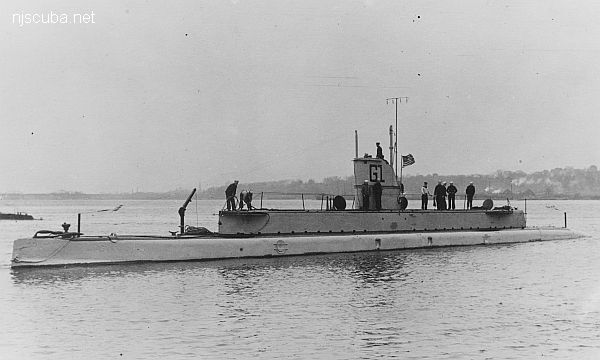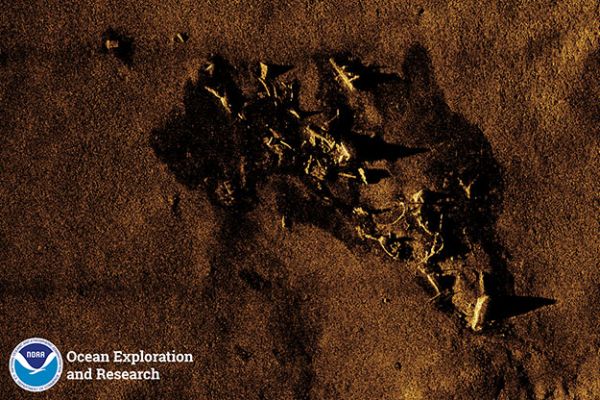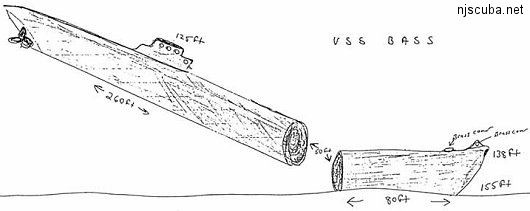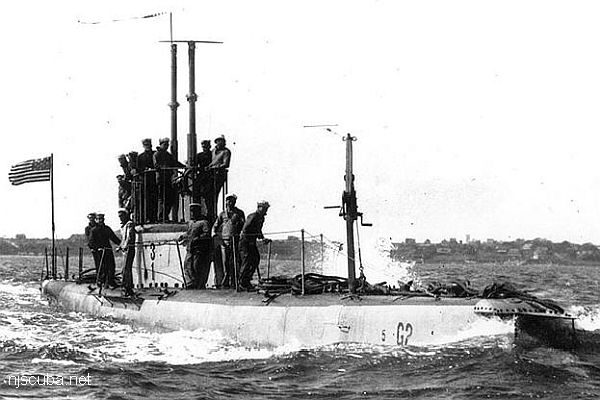USS G-1 SS-19

- Type:
- shipwreck, submarine, U.S. Navy
- Built:
- 1911, Lake Torpedo Boat Company, Newport News, VA USA
- Specs:
- ( 161 x 13 ft ) 400 tons, no crew
- Sunk:
- Tuesday June 21, 1921, deliberate - weapons test

Historical records suggest that a private salvor removed large sections of the G-1 for scrap in the 1962.
(Submarine No. 19: displacement 400 (surf.), 516 (subm.); length 161'; beam 13'1"; draft 12'2"; speed 14 knots (surf.), 10 knots (subm.); complement 26; armament 6 18" torpedo tubes; class G-1)
Seal (Submarine No. 19) was laid down on 2 February 1909 at Newport News, Va., by the Newport News Shipbuilding Co., under a subcontract from Lake Torpedo Boat Co.; launched on 9 February 1911; sponsored by Miss Margaret V. Lake, daughter of the submarine pioneer; renamed G-1 on 17 November 1911; and commissioned at the New York Navy Yard on 28 October 1912, Lt. Kenneth Whiting in command.
After fitting out in New York, G-1 proceeded to the Naval Torpedo Station, Rhode Island, arriving there on 30 January 1913. Attached to the Atlantic Submarine Flotilla, G-1 spent the next year and a half conducting dive training and torpedo firing exercises in Long Island Sound and Narragansett Bay. In preparation for her final acceptance trials in October 1913, the boat made a record dive of 256 feet in Long Island Sound. Financial considerations led to G-1 being put in reserve at New York on 15 June 1914.
G-1 was placed in full commission at New York on 6 February 1915, Lt (jg). Joseph M. Deem in command. In company with submarine G-2, tender Fulton (Submarine Tender No. 1) and tug Sonoma, G-1 sailed south for Norfolk on 25 March. Arriving there two days later, the submersible conducted maneuvers in Hampton Roads as part of the Third Division, Submarine Flotilla, Atlantic Fleet. On 2 April, while off Old Point Comfort, the boat grazed steamship Ocean View, wrecking the submersible’s wooden false bow.
After a short period at Norfolk for repairs, the division cruised south to Charleston, South Carolina, mooring there on 17 April. Heavy seas encountered during this coastwise passage caused the two G-class submarines to roll heavily, spring oil leaks, and pop engine rivets. Following a three-week yard period in Charleston, the two boats, accompanied by gunboat Castine and Fulton, proceeded back to New York on 6 May, arriving there three days later. Upon arrival, retired Radm. Yates Stirling Jr., senior aide on the staff of Commander, Submarine Flotilla, Atlantic Fleet, inspected the boat and concluded the G-class boats were crude and inefficient in comparison to current designs. Deeming “their military value … negligible” he urged that a field of scientific or experimental use be found for them.
G-1 departed New York on 23 May and proceeded to Newport where she became a school ship on the torpedo range. She also carried out harbor defense and patrol battle problems in Narragansett Bay. Aside from minor repairs at New York in June, this duty continued until 3 October when she set course with submarine tender Ozark (Monitor No. 7) for a training cruise to Chesapeake Bay. After making a few days of practice attack runs against the monitor off Fisherman’s Island, the boat returned to Newport on 12 October for inspection and crew changes; a week later, she shifted to the new submarine base at New London, Connecticut.
On 4 December, while the crew of G-1 was charging batteries, a circulating pump broke down and severely overheated the port engine. That mishap, combined with a steering gear overhaul at New York, kept ship’s force busy in the yard for the next thirteen months. While there, G-1 was assigned 19 as her official hull number on 12 June 1916. Finally, after a few days of familiarization training, the crew sailed the boat to New London on 23 January 1917.
Once there, G-1 began her new career as an experimental and instructional submersible. She acted as a school ship for the newly established Submarine Base and Submarine School at New London, playing an important role in training officers and men of the newly expanded submarine force. Concurrently, given the entry of the United States into World War I, G-1 tested submarine nets and detector devices for the Experiment Board. She served in a similar capacity at Nahant and Provincetown, Mass., assisting Aylwin (Destroyer No. 47) and steam yacht Margaret (SP-527) in the development and use of sound detection devices and experiments with the "K tube," a communications device. With German U-boats reported off the coast in June 1918, the submarine spent two four-day periscope and listening patrols off Nantucket as a defense screen for shipping.
Following the end of the war, G-1 conducted daily operations with enlisted students in connection with the Listener and Hydrophone School at New London. In August 1919, after a failed inspection by the Board of Inspection and Survey, the boat was laid up at New London in preparation for disposal. Towed to the Philadelphia Navy Yard on 30 January 1920 she was stripped of useful material and decommissioned on 6 March. She was designated as a target for depth charge experiments under the cognizance of the Bureau of Ordnance on 9 June.
Towed back to Narragansett Bay by Grebe (AM-43) in May 1921, the minesweeper made eight experimental depth charge attacks on ex-G-1 while the boat lay off Taylor's Point on 21 June. Damaged and flooded by those explosions, the battered submarine settled to the bottom in 90 feet of water. Several attempts to raise her failed and the wreck was officially abandoned.G-1 was struck from the Navy List on 29 August 1921.
from Navy historical records



Questions or Inquiries?
Just want to say Hello? Sign the .